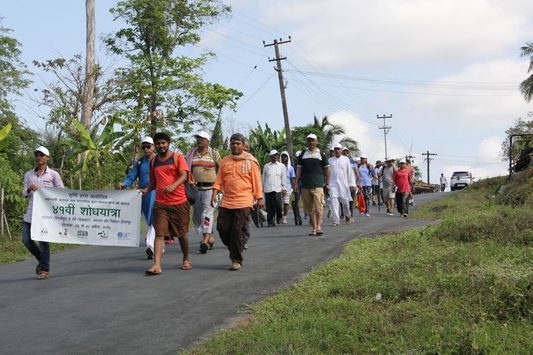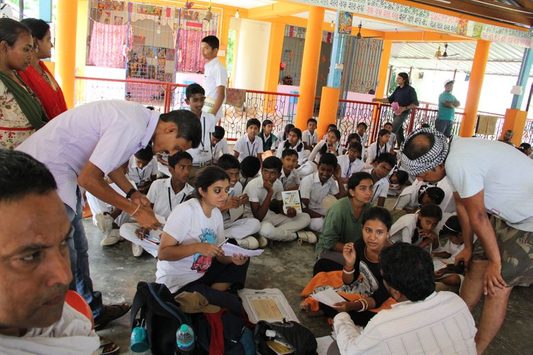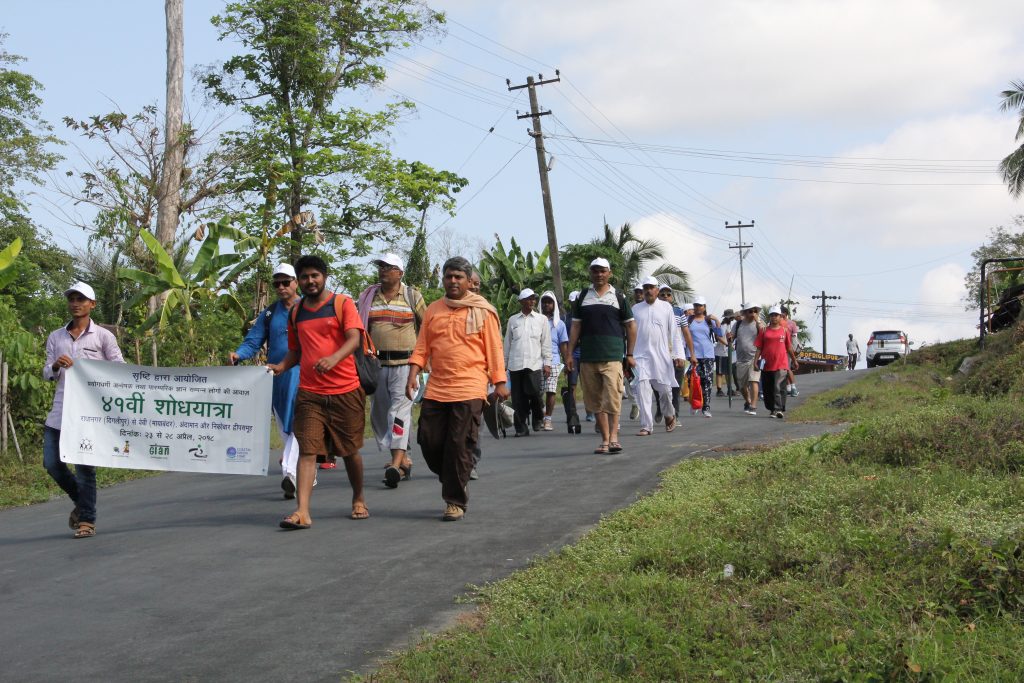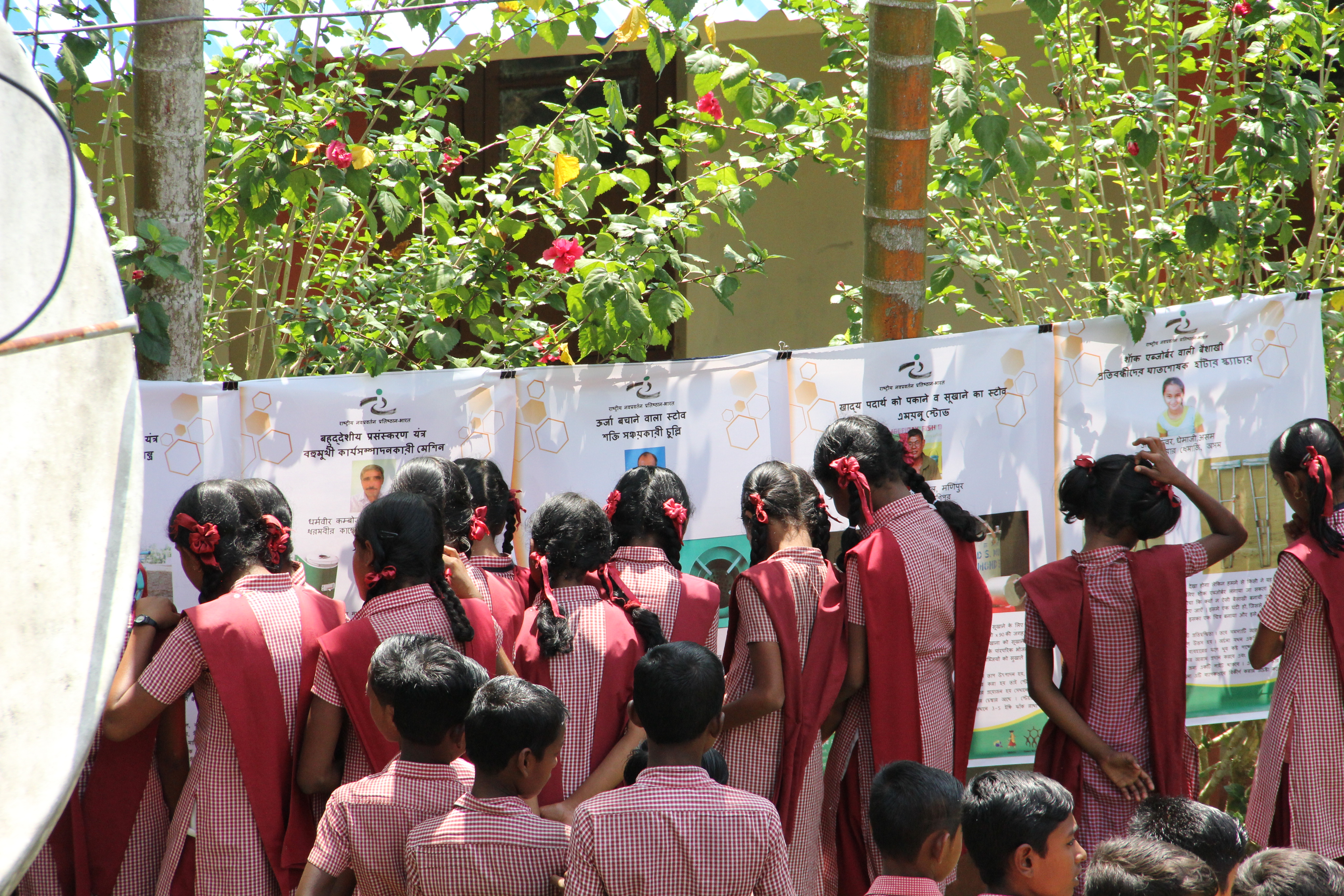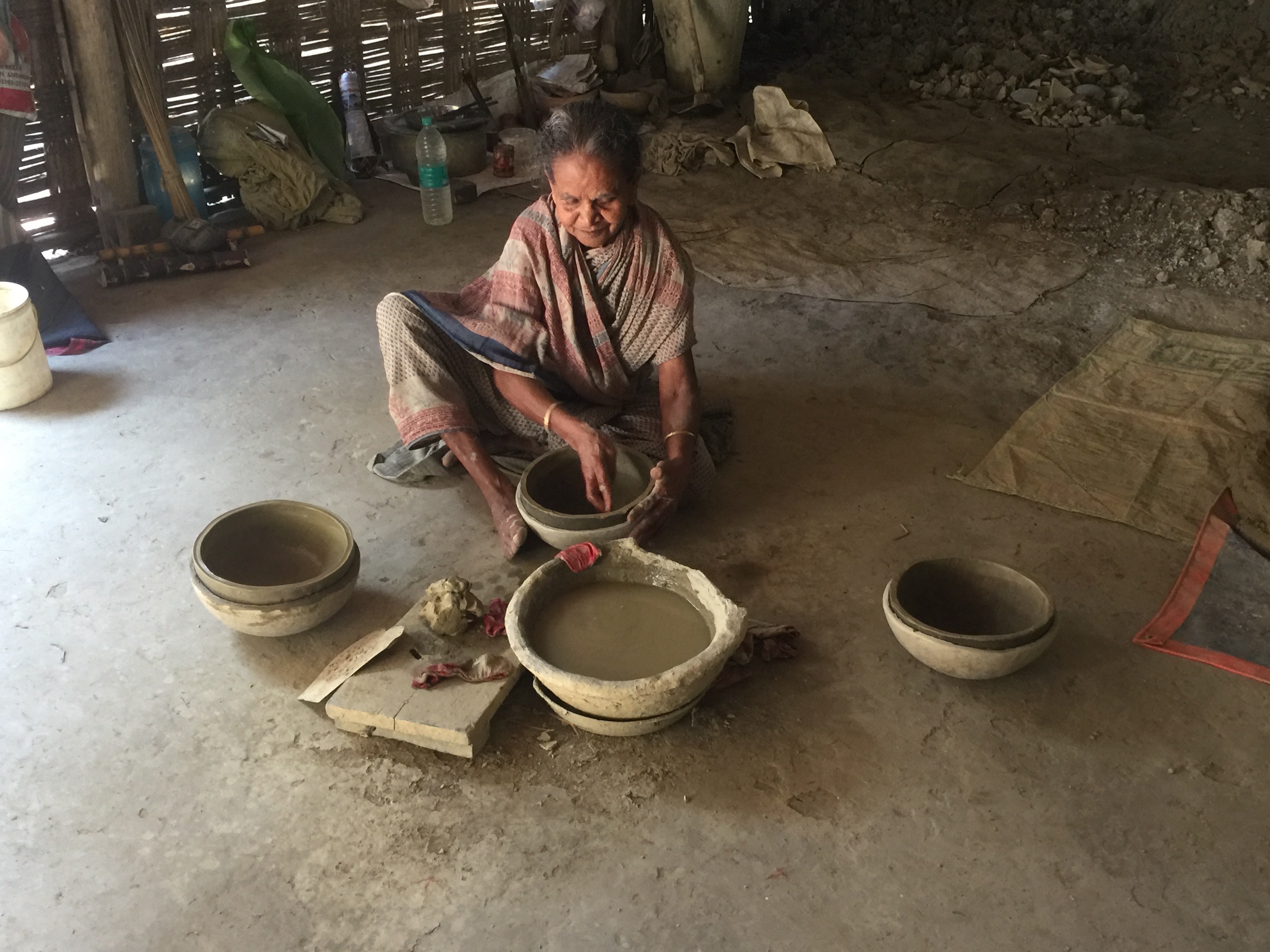Get Next Shodhyatra Update:
Phone:
079-27913293, 27912792
Email:
shodhyatra@sristi.org
41ST SHODHYATRA - ANDAMAN & NICOBAR ISLANDS (SOUTH INDIA)
NATURE FEELS, NATURE HEALS
Did it ever strike that a child’s toy could help in daily chores? Sukanto Das (class VII) sought an idea of attaching a sweeping mop to his toy car. This way he could play and also help his mother clean places where a broom would not reach.
The 41st Shodhyatra held in Andaman and Nicobar Islands from April 23rd-28th, 2018 enriched the yatris with such intriguing experiences, innovative ideas, herbal & cultural diversity and traditional knowledge.
The 41st Shodhyatra was pursued from Diglipur, North Andaman to Webi, Middle Andaman, covering a distance of 120 kms. The advent of the yatra was marked by an encounter with the members of the Jarawa community. This is an indigenous community residing on the islands along with Nicobaris, Sentineles and Onge tribes. The state ensures seclusion and special protection to the communities for preserving their identity. Any kind of communication, even photography is prohibited to avoid socio-cultural exploitation or fostering any kind of dependence among them. Is isolation the only solution to preserve tradition?
The islands are a mosaic of varied cultures with diverse ethnic groups from Bangladesh, Wesh Bengal, Chhattisgarh, Jharkhand, Myanmar, etc. residing together. They had blended their traditional practices with local endowments.
We started from Radha Nagar village, which gave us the chance to meet the youngest sarpanch in Andaman, Bhaskar Majumdar. He is a young enthusiastic leader who is against corruption and ensures practices integral to the community. He wishes to leave a legacy of corruption-free office behind.
Chanchal Singha Roy, founder of Coastal Green Zone, a voluntary organisation and five of his students joined us for the yatra here. Chanchal is a dedicated Government school teacher in Diglipur. He has nurtured many students with creativity and innovation. Out of the five students, who accompanied, Dipankar Das and Sumit Diswas had won the IGNITE Award in 2015 and 2016 respectively. And the remaining were young innovators; Shubrato Das and Saurabh Das have designed a water conservation technique for a Betel leaf farm using bamboos, and Pranav Das has collected over 500 different varieties of seeds for his seed bank. The agriculture department, Andaman supported and helped Shubrato and Saurab to diffuse their innovation in various villages.
Chanchal had organized a painting competition before Shodhyatra. These paintings reflected the student’s empathy towards nature. Nirveda, Class VIII, painted trees in a beautiful and evocative manner. She also made a perceptive portrayal of the excessive use of plastic harming fishes as well as the terrestrial environment. She made line drawing of many bottles and then made a single sprout in between to draw attention to the agony of life. Another student drew a fish in the tear falling from the eye; as if telling us to see the sea from a fish’s view. The winning paintings were exhibited in various schools visited during the yatra.

School exhibitions also involved the display of educative posters, innovations and their prototypes. In Swarajgram school, students showed disappointment on a mere showcase of innovations. On being persuaded by the students, yatris demonstrated the working of various innovations. Trees were planted in each school that was visited. It was experienced that the students were talented and most of them were blessed with a melodious voice.
During the idea competitions, they presented some eye-catching ideas. Anjana Mistry (class IX, Govt. Senior Secondary school, Swarajgram) shared the idea of an in-built camera in spectacles for students to record the lessons. Aman Biswas (class VIII, Govt. Senior Secondary school, Swarajgram) wanted to control the excessive use of diesel engines by using wind generated energy efficient batteries to run ferry/boats. Tithi Gharami (class III, Govt. Primary school, DB gram) shared the idea of an oversized umbrella that could fit in more than two people at a time. Also, she wanted to design it in a manner to help in water harvesting. Rahul Mandal from village Nabagram shared the idea of a multiple-purpose harvesting machine that could be used for both pulses and rice.
Students also shared number eco-friendly ideas such as solar panelled roof, solar operated vehicle, provision of dustbins in school buses, plastic bottles recycled into plastic pipes and recyclable notebooks. Prabha Bhengra (class X, Govt. Secondary School, Village Parangra) questioned why use plastic packets for chips and other eateries when there are diverse kinds of leaves available? This way both health and nature could be preserved. Amidst of the innovative ideas, Shodhyatris met Mohan Kumar Dutta, a student in Mohanpur school who had invented a unique wooden rat catching device.
The next stop was Milangram village, led by a Sarpanch elected unanimously for the 15th time. His dedication and hard work is highly admired. Through out the yatra, we got a chance to meet many such promiscuous and dedicated local leaders. Also, we were introduced to Shumanto Haldar, a dropout from school. He barely knew how to read and write but could repair any piece of machinery. He made gadgets from electronic waste. He had developed an air pump using the broken refrigerator’s compressor, wood cutting device from a scooter and many other gadgets. Most celebrated of his innovations are the speakers he had developed. Prof. Anil Gupta was quite impressed by the sound quality and gave him an order for three pairs of speakers for SRISTI and himself. Shumanto was so passionate about gadgets that he felt the machines could talk to him. His house was full of broken gadgets, wires and electronics. He also joined the yatris for the yatra ahead.

The next village, Madhupur was endowed with creative skills. Women showcased their crafts : utility items made of waste such as chappals from an old pair of jeans, handicrafts made out of coconut shells and husk, handicrafts made of bamboo, wool or other materials. A number of yatris bought many of these crafts. Even the Karen Community (originally inhabited from Myanmar) exhibited fine craftsmanship.
Creativity was engraved in the roots of the communities across the islands. They possessed ethnic traditional handlooms and crafts made of bamboo and cane. Between RKgram and Khudirampur, we can across a Mason family. The family has been making ceramic pots for the community with hand tools and no modern amenities, not even the potter’s wheel.
Recipe competitions were also a fine showcase of their talent. A variety of unique recipes with additional health benefits were served. Veronica Kujur (Kala Pahad village) shared the recipe of Papaya sabzi that she claimed to be beneficial for fever; Zubeda Ibrahm (Head Mistress, DB Gram school) shared the recipe of drumstick soup enriched with vitamins and iron. Similarly, Betang ki sabzi (Baby bait vegetable) by Kamla Bai, Kala Pahad village, was reported to help reduce body pain. Other recipes shared were Khatta meetha aam (Mango) enriched with vitamin C, Singapur Bhaji for blood pressure, sugar and stomach problems, Kela Phool ki sabzi (Banana Flower) for iron, stomach illness, and haemoglobin, and many more. In Parangara village, children also participated along with their mothers, teachers and Anganwadi workers.

In RK gram village, we met Dipti Biswas. She along with her mother had prepared a complete meal for all the yatris. She participated in the recipe competition and also motivated many others.
A similar experience we had in Kala Pahad, where we met Anjana Roy, an Anganwadi worker. Kala Pahad is situated in the middle of a dense forest. The families residing in this area are considered as encroachers and are denied the basic facilities, despite of enriching the landscapes and adding to the biodiversity and local knowledge systems for more than forty years of settlement. They have no access to water connection or electricity. In such conditions, Anjana made it possible for the Shodhyatris to retire for a night and hold successful sessions and competitions. Sprouted beans with jaggery and crushed coconut served on banana leaf, as breakfast was a delight.
Throughout the yatra, a number of local herbal healers came forward to share their knowledge. Ashutosh Das, herbal healer from Laxmipur shared recipes to treat jaundice and spine injuries. Similarly, Narayan Chander Das, herbal healer from Madhupur shared the medication for pain, rheumatism, and paralysis. Bidhan Roy, herbal healer from Paschim Sagar shared medications for snakebite, toothache, reducing labour pain, treating malaria, dandruff and lice, kidney stone, gastro-intestinal disorder. Deepak Biswas from Kishori Nagar also shared his herbal recipes for curing centipede bite, jaundice, diabetes and stomach worms.
It seemed the communities had well preserved and disseminated their traditional knowledge, as even students possessed a decent knowledge about herbal medicines.
Mantosh Bisht and Rahul Kumar (Class IX, Parangara booti patti reported leaf juice of (Eupatorium odoratum) pather and kuchi (Kalanchoe pinnata) useful for curing cuts and wounds, and treating stomach ache respectively Tanmay Mandal (Class V, Dbgram) suggested chewing young tetul (Tamarindus indica) leaves could give relief from cough; Barsa Bepari recommended leaf juice of Sheoli (Nyctanthes arbor-tristis) for fever and Sudeepa Dakua (class V) reported leaf juice of kalmegh (Andrographis paniculata) effective for de-worming. Young knowledge bearers shared many more such herbal medications.
A variety of the reported herbs have been collected and sent to SRISTI lab for further testing.
INNOVATIVE MINDS
People who think differently are all around us. During our halt in Laxmipur village, along the way, we spotted a number of modified porter rickshaws with scooter mechanism. Upon asking, we were told that a local merchant Mithun has developed them. Mithun was in his mid-30 and was very enthusiastic about innovations. His most commonly used innovation was the hydraulic hollow-brick machine. He stated that mostly brick making machines were imported from Gujarat, which cost a fortune. But the tables have turned and Mithun develops most of the hydraulic hollow-brick machines uses in Andaman today… These are easily affordable and also accompanied with a descent after-sales-service. Also, he has developed an attachment that helps a farmer to use a power tiller as a thrasher, and an arena-nut stripper. Currently, he is working on developing a multi-purpose machine that could thrash rice and also separate areca nut from its shell.
Another local innovator, we came across was Saw Sangtho from the Karen community. He had fixed a motor engine to the traditional dungi (boats used by Karens to fish); such a fine merger of tradition and modern technology. Similarly, Saw Pepe, another Karen had modified his scooter into a tractor to much fields. Also, he had developed rice winnower and a multi-purpose mini cart.
The traditional chulha used across Andaman was uniquely designed to work even in monsoons. Portable chulha in a bucket was also seen. A team from the drama division of the Bureau of outreach and communication had accompanied the yatris. They conducted puppet shows, plays and dances to support the “Beti Bachao, Beti Padhao” mission. The last village, Mohanpur gave us an opportunity to meet the Karen community and seek knowledge from them. The yatris visited a local exhibition, exhibiting the Karen culture and artefacts. Also, a meeting was held there with the Governor, DGP, State Chief Secretary and the Information and Broadcasting department representatives.
SOCIAL CONDITIONS AND SUGGESTIONS
A number of village/community meetings were held to interact with local farmers, house-keepers, herbal healers, and innovators. We shared our knowledge and answered queries for them. For instance, a villager shared his concern for the small size of the fishes in ponds. To this, Prof. Anil Gupta recounted his experience from Nagaland Shodhyatra and shared the practice of putting bamboo sticks in the ponds, against which fishes would rub their skin. This helps in removing dead skin alas helping them grow in size. Hence, nurturing the Network’s true purpose; disseminating knowledge.
The sanitation standards in villages and schools were found to be quite high but it was observed that national mission for providing toilets in every household hadn’t yielded much results.
Other than that, the state had been kind to provide a government school in every village, even in encroached areas. Seeing the pain of the residents of the encroached areas, it is suggested that alternative ways of producing electricity through solar energy be considered. Also, it is sought that the local women and farmer groups can participate in Sattvik, traditional food festival to be held on 23rd – 26th december 2018. The land also holds an opportunity for building tourism by promoting nature resorts. These would nurture better job opportunities for the local communities and hence aid in their development.
Overall the yatris derived ample learning and experiences from the yatra. The land is endowed with mother nature’s blessings. One can see hundreds of years old trees planted beside the roads.
